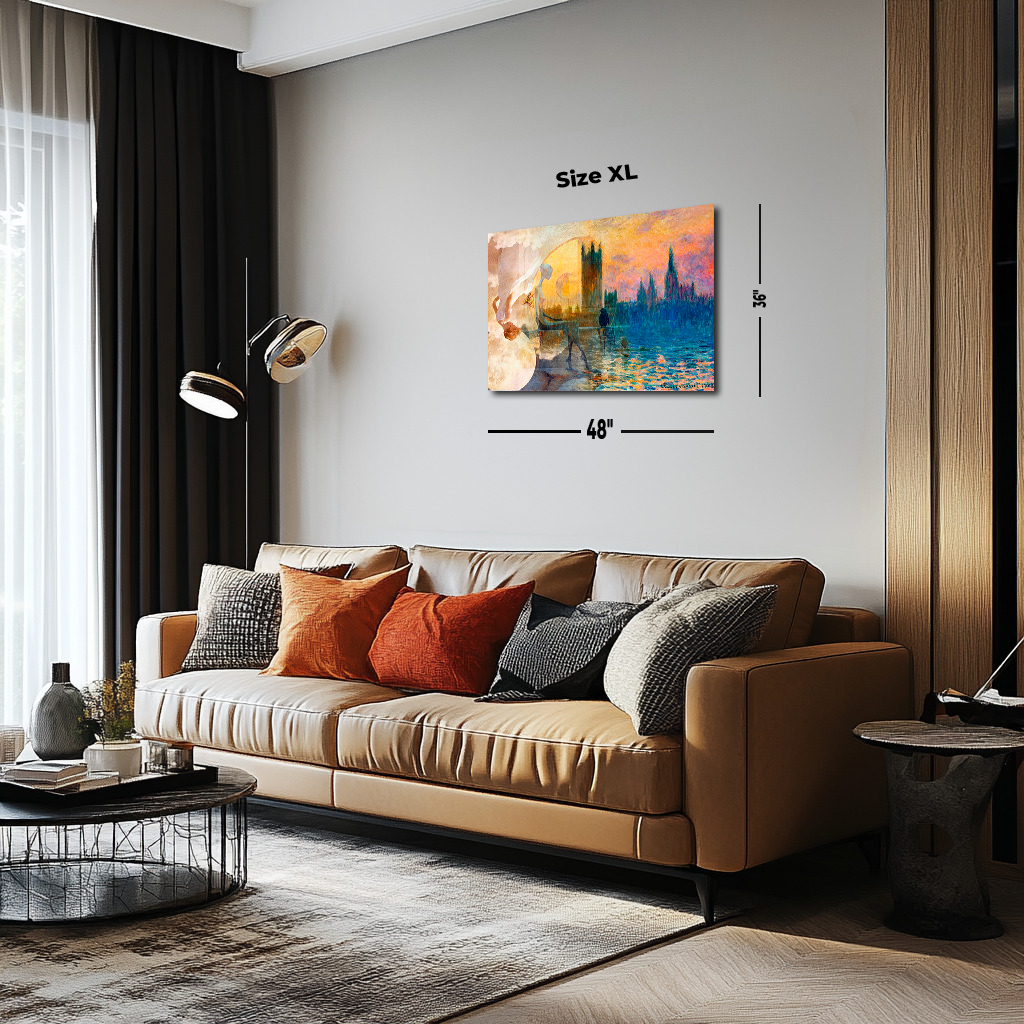Reflections Beyond Reality: Monet’s Parliament in a Surreal Light
"Reflections Beyond Reality: Monet’s Parliament in a Surreal Light" reimagines Claude Monet’s Houses of Parliament series as a surreal exploration of light, memory, and humanity’s uncertain future. Incorporating ethereal figures, a crescent moon, and a dark bird, it evokes themes of reflection, cycles, and transformation. Surreal elements, including a foreboding creature and an inverted woman with a butterfly, symbolize the fragility of justice and the destabilizing effects of technology, particularly artificial intelligence. By blending Monet’s Impressionist mastery with contemporary symbolism, the piece becomes a meditation on impermanence, progress, and the interconnectedness of all things.
Please see Below for Details…
Hotline Order:
Mon - Fri: 07AM - 06PM
404-872-4663
Claude Monet’s Houses of Parliament series, painted between 1900 and 1904, stands as one of the most celebrated works in Impressionist art. The series captures the interplay of light, atmosphere, and shadow over the iconic Gothic architecture of the Houses of Parliament in London. Monet’s ability to immortalize fleeting moments of change—fog rolling over the Thames, the golden glow of sunrise, or twilight’s quiet descent—gave the world a vision that was both ethereal and timeless. This surreal reinterpretation of Monet’s masterpiece builds on his fascination with light and transformation while weaving in abstract elements, celestial symbolism, and allegorical figures to create a layered exploration of reality, justice, and humanity’s uncertain future.
At its core, this artwork reimagines the Houses of Parliament in a surreal context. The majestic silhouette of the Parliament building rises at the center of the composition, illuminated by a radiant golden light that seems to bleed into the surrounding atmosphere. This light, reminiscent of Monet’s original palette, is warm and enveloping, evoking hope and renewal. Below, the cool blues and greens of the reflective waters create a dynamic interplay of light and shadow, capturing the ephemeral beauty of natural transitions.
Yet this reinterpretation introduces a deeply symbolic narrative beyond Monet’s original impression. To the left of the Parliament building lies a surreal and haunting figure—a creature born of abstract forms and otherworldly shadows. This figure is not merely decorative but a forewarning of the future in peril. It symbolizes the unpredictable consequences of technological advancement, particularly the advent of artificial intelligence. This foreboding presence, both alien and unsettling, suggests a dystopian future where the constructs of law and justice—once represented by the Parliament—may be irrevocably altered. Its placement in the composition implies that even the most enduring institutions are not immune to the pressures of progress and disruption.
The figure of a woman, positioned upside down to the left of the Parliament, adds another poignant layer to this narrative. Her dress, flowing and inverted, creates a visual metaphor for the overturning of societal norms and systems. Resting delicately on her knee is a butterfly, a fragile emblem of peace and transformation. However, its placement in such a disoriented context suggests the fragility of justice and the innocence that may be lost in an era where legal systems and moral frameworks are subject to the influence of technology. The woman’s upside-down posture further underscores the destabilization of what was once serene and balanced, reflecting the profound uncertainty of navigating an evolving societal landscape.
A crescent moon, glowing near the center of the composition, becomes a beacon of celestial symbolism. Representing cycles, intuition, and the passage of time, the moon cradles one of the ethereal figures that blend seamlessly into the scene. Another figure gazes toward the Parliament, their form dissolving into light and shadow, a reflection of humanity’s collective longing for stability amid constant change. Together, these figures embody the connection between earthly experiences and cosmic truths, suggesting that the challenges faced by society today are part of larger, timeless cycles.
Monet’s original use of color in his Houses of Parliament series was revolutionary, relying on vibrant golds, deep purples, and shadowy blues to evoke atmosphere and emotion. This reinterpretation honors that legacy while expanding it. The fiery tones of the sky suggest energy, urgency, and transformation, while the deep blues of the water provide a calming yet introspective counterpoint. The bright golden light, which dominates the upper portion of the piece, creates a sense of hope, even as the surreal elements introduce tension and uncertainty.
The dark bird perched near the Parliament adds an enigmatic element to the piece. Traditionally a symbol of transition, mystery, or forewarning, its presence contrasts with the luminous tones of the composition. The bird becomes a reminder of the fleeting nature of time and the inevitability of change, reinforcing Monet’s original themes of ephemerality while drawing attention to the precarious balance of the present.
The reflections in the water act as a metaphor for memory and perception. They capture the essence of the scene above while distorting it, reminding viewers that our understanding of history and progress is always shaped by perspective. This distortion is further emphasized by the abstract and surreal elements, which blend seamlessly into the composition, creating a dreamlike dialogue between reality and imagination.
As an artist, my intention with this reinterpretation was to honor Monet’s mastery of light and atmosphere while pushing the boundaries of his vision into new conceptual realms. Monet’s work captured the physical beauty of his surroundings, but it also conveyed an emotional depth that resonated with viewers across generations. This piece expands on that foundation, exploring not only the fleeting beauty of light but also the complex and often contradictory emotions tied to change, progress, and memory. By introducing surreal and symbolic elements, this reinterpretation seeks to engage viewers on a deeper, more introspective level.
The addition of the surreal creature to the left of the Parliament and the inverted woman with the butterfly brings an urgent contemporary relevance to the piece. They reflect the challenges of an uncertain future where technological advancements, like artificial intelligence, could disrupt the foundations of justice and governance. The moon, figures, and shimmering water act as counterpoints, suggesting that even in times of uncertainty, there is a continuity to human experience that transcends the present moment.
This artwork is special because it bridges Monet’s Impressionist legacy with the imaginative freedom of surrealism. It transforms a familiar landscape into a multidimensional narrative that explores both the physical and metaphysical realms. By blending the timeless beauty of Monet’s vision with contemporary concerns, it invites viewers to reflect on their own connections to time, place, and the cycles of life, making it a deeply resonant and transformative piece.
Add your review
Your email address will not be published. Required fields are marked *
Please login to write review!
Looks like there are no reviews yet.








